Global Strategy: Addressing Material Challenges in Australian Market
VerifiedAdded on 2023/06/03
|5
|1052
|144
Essay
AI Summary
This essay addresses the challenges a company faces when expanding into Australia due to differing material regulations. It highlights the initial problem of fabrics used in the United States not meeting Australian standards, potentially hindering revenue and expansion plans. The essay emphasizes the importance of understanding Australian laws, regulations, and consumer preferences to ensure product compliance and market acceptance. It suggests exploring alternative materials, including those sourced from indigenous Australian producers, to gain a competitive advantage. The paper also underscores the need for comprehensive knowledge of Australian labeling and safety standards to modify core competitive areas and establish a strong brand image in the global market. Ultimately, it aims to create a strategy that aligns with both governmental requirements and consumer expectations in Australia.
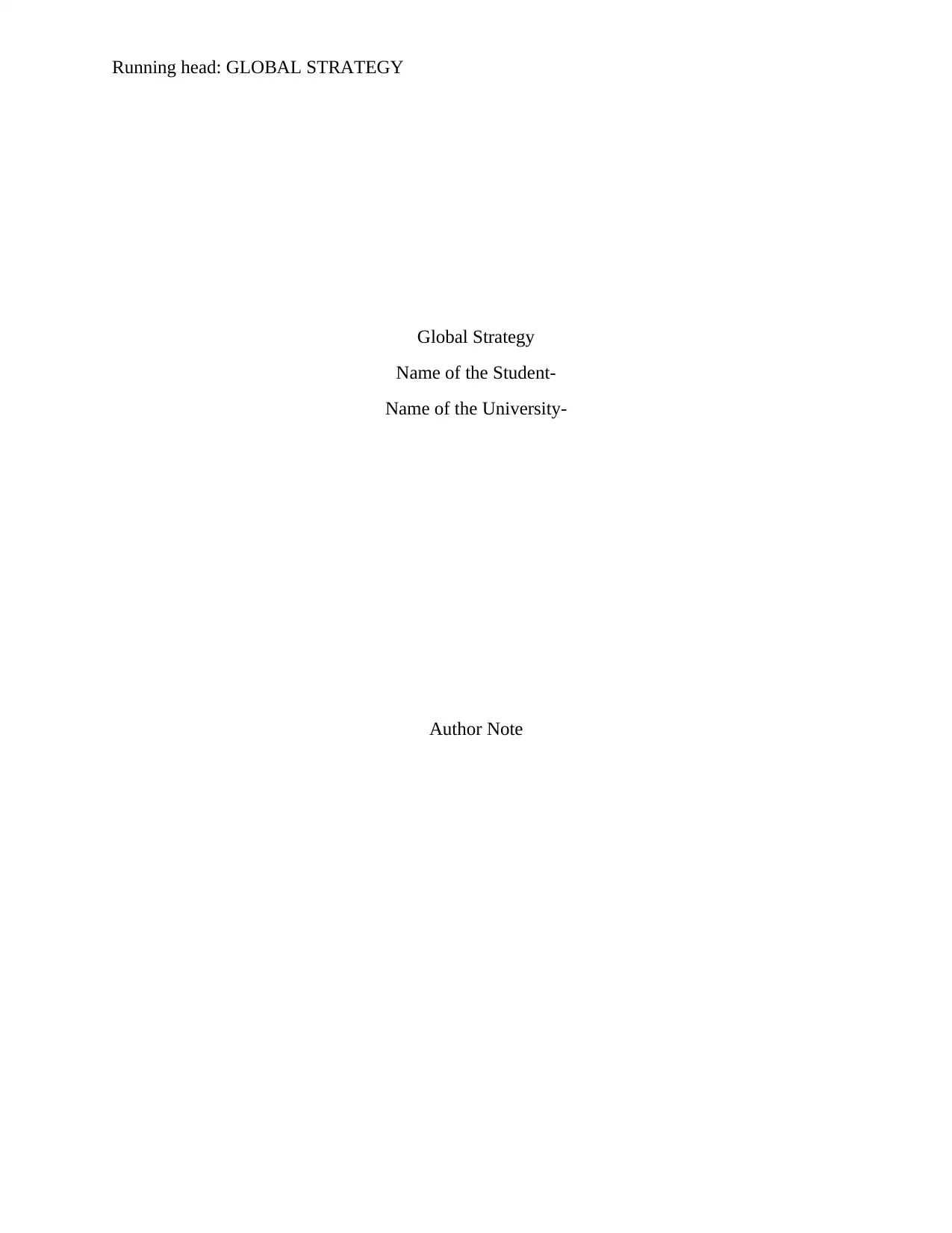
Running head: GLOBAL STRATEGY
Global Strategy
Name of the Student-
Name of the University-
Author Note
Global Strategy
Name of the Student-
Name of the University-
Author Note
Paraphrase This Document
Need a fresh take? Get an instant paraphrase of this document with our AI Paraphraser
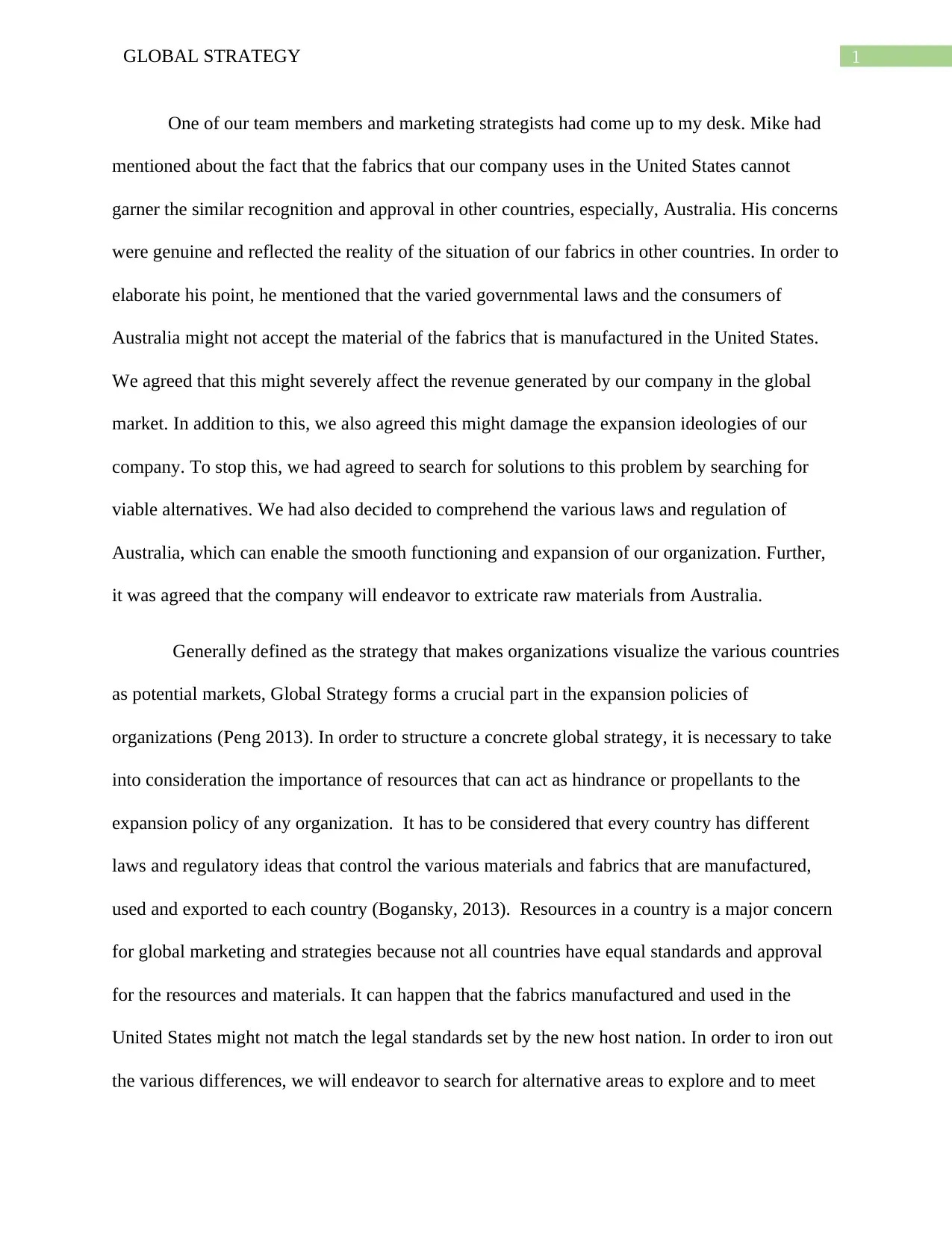
1GLOBAL STRATEGY
One of our team members and marketing strategists had come up to my desk. Mike had
mentioned about the fact that the fabrics that our company uses in the United States cannot
garner the similar recognition and approval in other countries, especially, Australia. His concerns
were genuine and reflected the reality of the situation of our fabrics in other countries. In order to
elaborate his point, he mentioned that the varied governmental laws and the consumers of
Australia might not accept the material of the fabrics that is manufactured in the United States.
We agreed that this might severely affect the revenue generated by our company in the global
market. In addition to this, we also agreed this might damage the expansion ideologies of our
company. To stop this, we had agreed to search for solutions to this problem by searching for
viable alternatives. We had also decided to comprehend the various laws and regulation of
Australia, which can enable the smooth functioning and expansion of our organization. Further,
it was agreed that the company will endeavor to extricate raw materials from Australia.
Generally defined as the strategy that makes organizations visualize the various countries
as potential markets, Global Strategy forms a crucial part in the expansion policies of
organizations (Peng 2013). In order to structure a concrete global strategy, it is necessary to take
into consideration the importance of resources that can act as hindrance or propellants to the
expansion policy of any organization. It has to be considered that every country has different
laws and regulatory ideas that control the various materials and fabrics that are manufactured,
used and exported to each country (Bogansky, 2013). Resources in a country is a major concern
for global marketing and strategies because not all countries have equal standards and approval
for the resources and materials. It can happen that the fabrics manufactured and used in the
United States might not match the legal standards set by the new host nation. In order to iron out
the various differences, we will endeavor to search for alternative areas to explore and to meet
One of our team members and marketing strategists had come up to my desk. Mike had
mentioned about the fact that the fabrics that our company uses in the United States cannot
garner the similar recognition and approval in other countries, especially, Australia. His concerns
were genuine and reflected the reality of the situation of our fabrics in other countries. In order to
elaborate his point, he mentioned that the varied governmental laws and the consumers of
Australia might not accept the material of the fabrics that is manufactured in the United States.
We agreed that this might severely affect the revenue generated by our company in the global
market. In addition to this, we also agreed this might damage the expansion ideologies of our
company. To stop this, we had agreed to search for solutions to this problem by searching for
viable alternatives. We had also decided to comprehend the various laws and regulation of
Australia, which can enable the smooth functioning and expansion of our organization. Further,
it was agreed that the company will endeavor to extricate raw materials from Australia.
Generally defined as the strategy that makes organizations visualize the various countries
as potential markets, Global Strategy forms a crucial part in the expansion policies of
organizations (Peng 2013). In order to structure a concrete global strategy, it is necessary to take
into consideration the importance of resources that can act as hindrance or propellants to the
expansion policy of any organization. It has to be considered that every country has different
laws and regulatory ideas that control the various materials and fabrics that are manufactured,
used and exported to each country (Bogansky, 2013). Resources in a country is a major concern
for global marketing and strategies because not all countries have equal standards and approval
for the resources and materials. It can happen that the fabrics manufactured and used in the
United States might not match the legal standards set by the new host nation. In order to iron out
the various differences, we will endeavor to search for alternative areas to explore and to meet
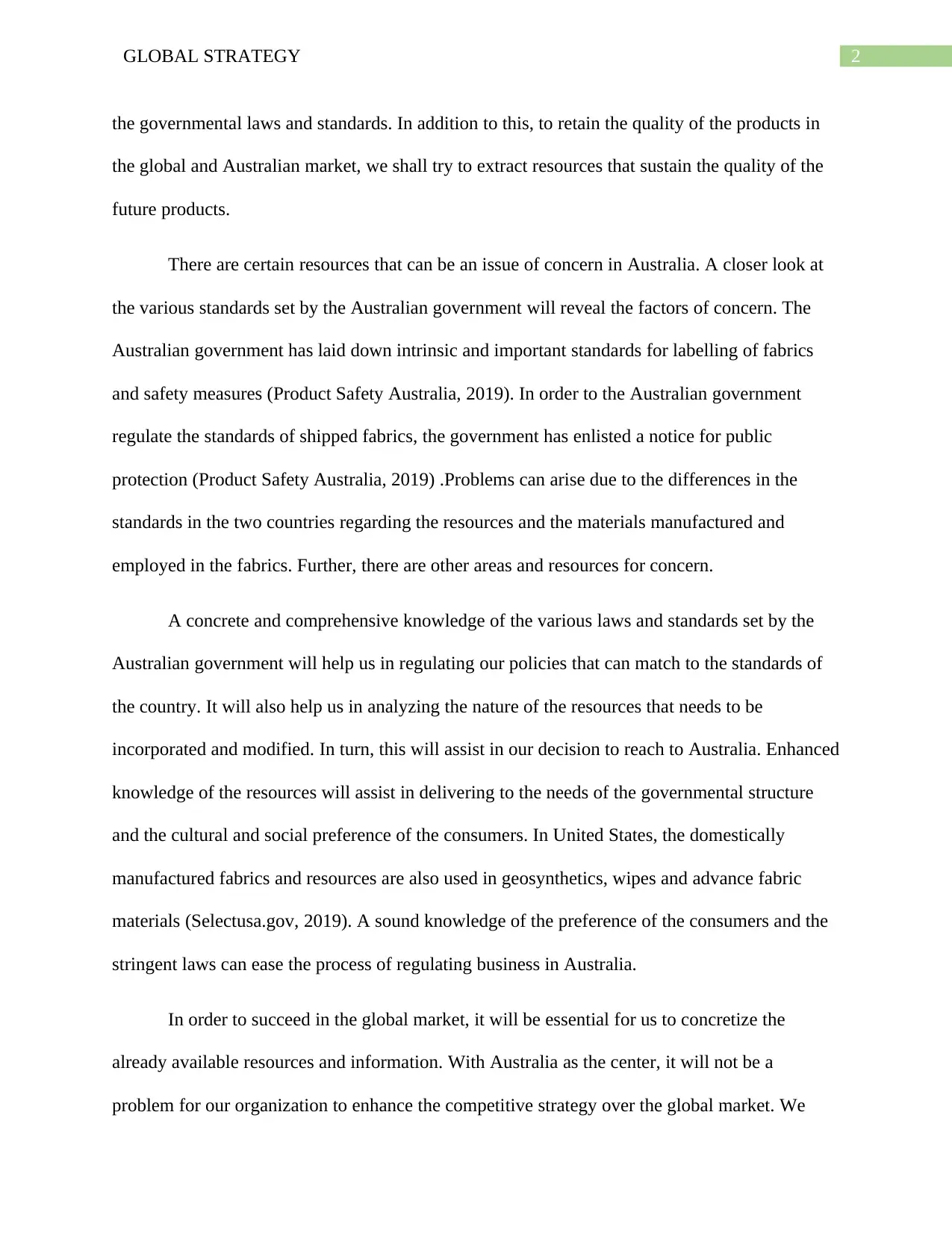
2GLOBAL STRATEGY
the governmental laws and standards. In addition to this, to retain the quality of the products in
the global and Australian market, we shall try to extract resources that sustain the quality of the
future products.
There are certain resources that can be an issue of concern in Australia. A closer look at
the various standards set by the Australian government will reveal the factors of concern. The
Australian government has laid down intrinsic and important standards for labelling of fabrics
and safety measures (Product Safety Australia, 2019). In order to the Australian government
regulate the standards of shipped fabrics, the government has enlisted a notice for public
protection (Product Safety Australia, 2019) .Problems can arise due to the differences in the
standards in the two countries regarding the resources and the materials manufactured and
employed in the fabrics. Further, there are other areas and resources for concern.
A concrete and comprehensive knowledge of the various laws and standards set by the
Australian government will help us in regulating our policies that can match to the standards of
the country. It will also help us in analyzing the nature of the resources that needs to be
incorporated and modified. In turn, this will assist in our decision to reach to Australia. Enhanced
knowledge of the resources will assist in delivering to the needs of the governmental structure
and the cultural and social preference of the consumers. In United States, the domestically
manufactured fabrics and resources are also used in geosynthetics, wipes and advance fabric
materials (Selectusa.gov, 2019). A sound knowledge of the preference of the consumers and the
stringent laws can ease the process of regulating business in Australia.
In order to succeed in the global market, it will be essential for us to concretize the
already available resources and information. With Australia as the center, it will not be a
problem for our organization to enhance the competitive strategy over the global market. We
the governmental laws and standards. In addition to this, to retain the quality of the products in
the global and Australian market, we shall try to extract resources that sustain the quality of the
future products.
There are certain resources that can be an issue of concern in Australia. A closer look at
the various standards set by the Australian government will reveal the factors of concern. The
Australian government has laid down intrinsic and important standards for labelling of fabrics
and safety measures (Product Safety Australia, 2019). In order to the Australian government
regulate the standards of shipped fabrics, the government has enlisted a notice for public
protection (Product Safety Australia, 2019) .Problems can arise due to the differences in the
standards in the two countries regarding the resources and the materials manufactured and
employed in the fabrics. Further, there are other areas and resources for concern.
A concrete and comprehensive knowledge of the various laws and standards set by the
Australian government will help us in regulating our policies that can match to the standards of
the country. It will also help us in analyzing the nature of the resources that needs to be
incorporated and modified. In turn, this will assist in our decision to reach to Australia. Enhanced
knowledge of the resources will assist in delivering to the needs of the governmental structure
and the cultural and social preference of the consumers. In United States, the domestically
manufactured fabrics and resources are also used in geosynthetics, wipes and advance fabric
materials (Selectusa.gov, 2019). A sound knowledge of the preference of the consumers and the
stringent laws can ease the process of regulating business in Australia.
In order to succeed in the global market, it will be essential for us to concretize the
already available resources and information. With Australia as the center, it will not be a
problem for our organization to enhance the competitive strategy over the global market. We
⊘ This is a preview!⊘
Do you want full access?
Subscribe today to unlock all pages.

Trusted by 1+ million students worldwide
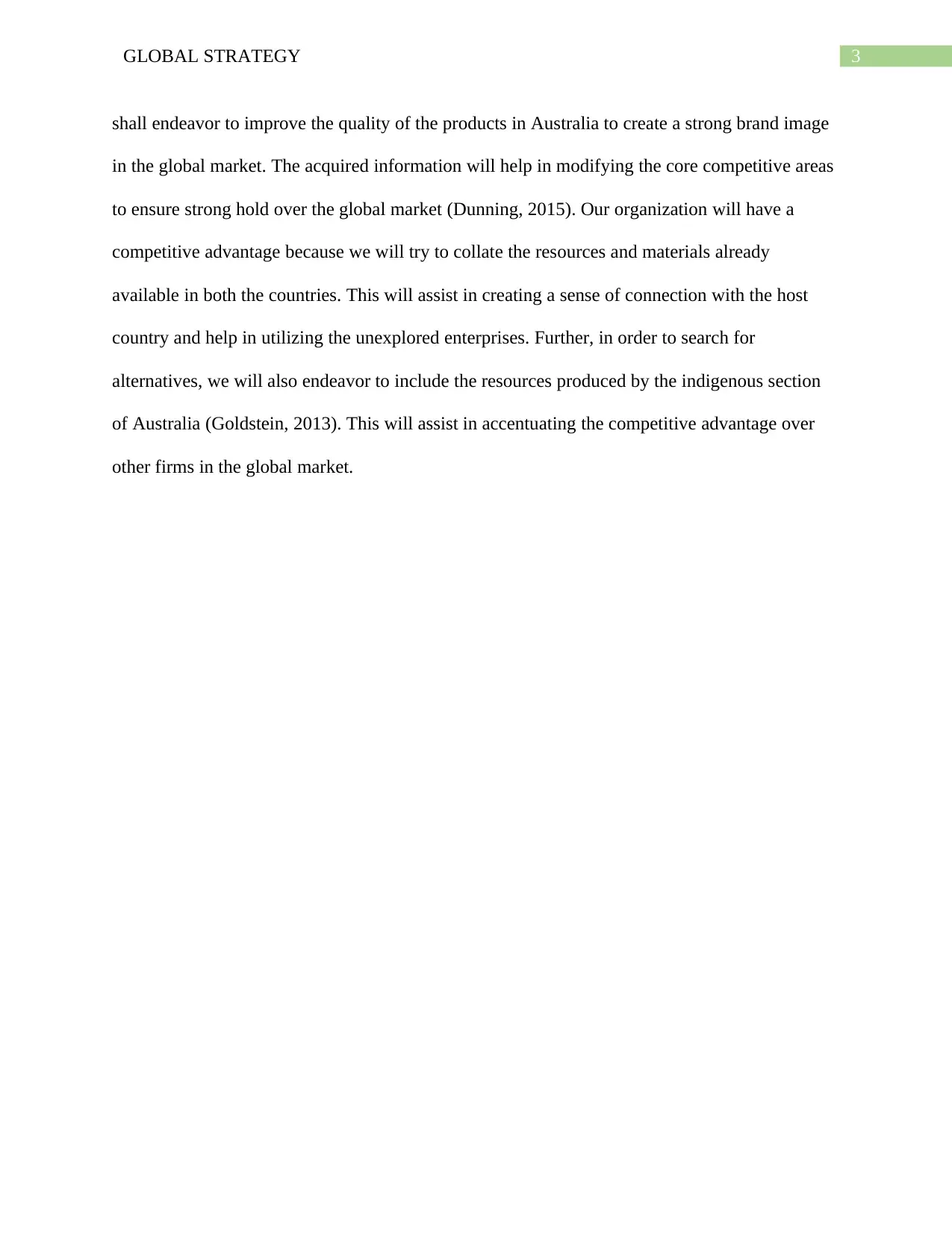
3GLOBAL STRATEGY
shall endeavor to improve the quality of the products in Australia to create a strong brand image
in the global market. The acquired information will help in modifying the core competitive areas
to ensure strong hold over the global market (Dunning, 2015). Our organization will have a
competitive advantage because we will try to collate the resources and materials already
available in both the countries. This will assist in creating a sense of connection with the host
country and help in utilizing the unexplored enterprises. Further, in order to search for
alternatives, we will also endeavor to include the resources produced by the indigenous section
of Australia (Goldstein, 2013). This will assist in accentuating the competitive advantage over
other firms in the global market.
shall endeavor to improve the quality of the products in Australia to create a strong brand image
in the global market. The acquired information will help in modifying the core competitive areas
to ensure strong hold over the global market (Dunning, 2015). Our organization will have a
competitive advantage because we will try to collate the resources and materials already
available in both the countries. This will assist in creating a sense of connection with the host
country and help in utilizing the unexplored enterprises. Further, in order to search for
alternatives, we will also endeavor to include the resources produced by the indigenous section
of Australia (Goldstein, 2013). This will assist in accentuating the competitive advantage over
other firms in the global market.
Paraphrase This Document
Need a fresh take? Get an instant paraphrase of this document with our AI Paraphraser
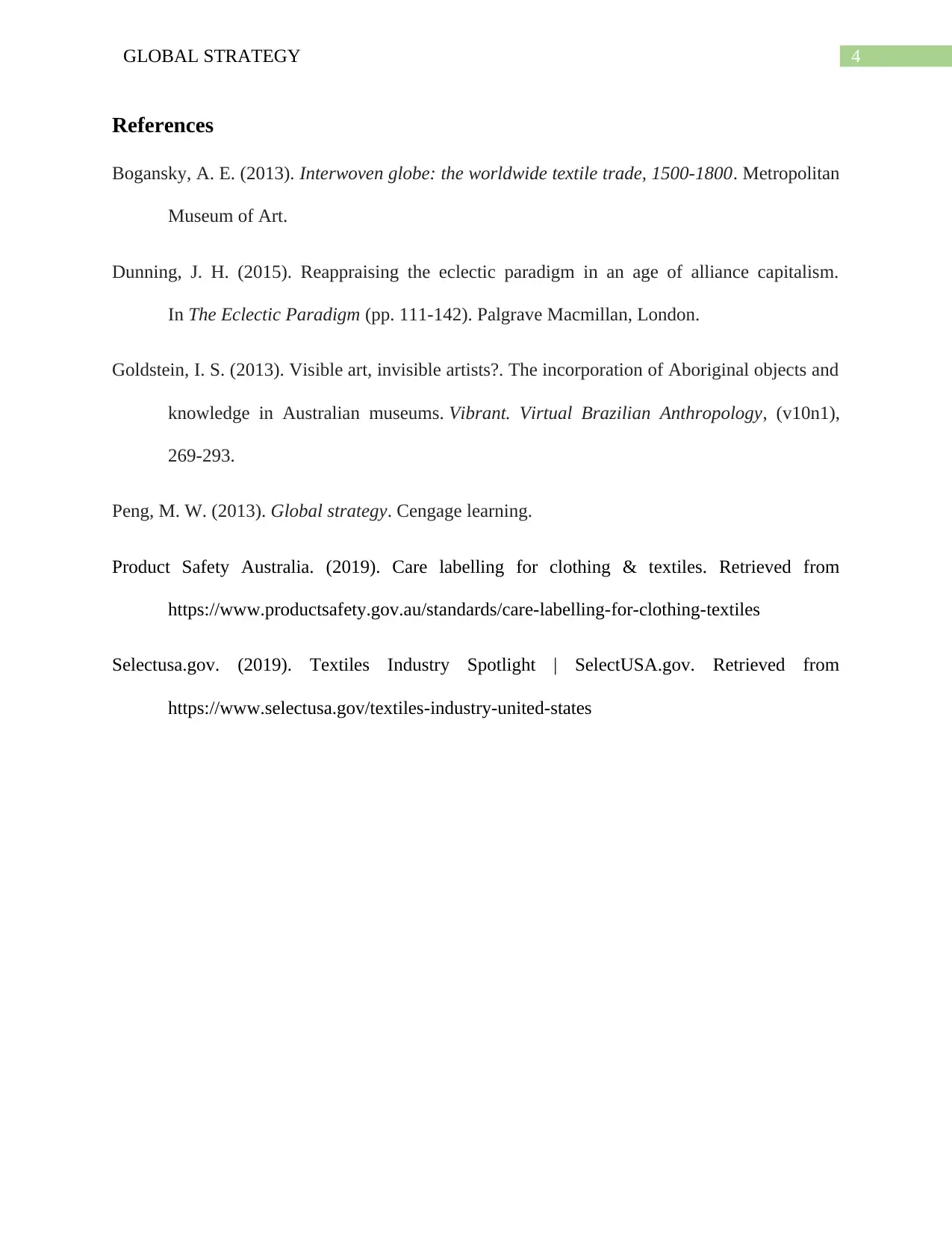
4GLOBAL STRATEGY
References
Bogansky, A. E. (2013). Interwoven globe: the worldwide textile trade, 1500-1800. Metropolitan
Museum of Art.
Dunning, J. H. (2015). Reappraising the eclectic paradigm in an age of alliance capitalism.
In The Eclectic Paradigm (pp. 111-142). Palgrave Macmillan, London.
Goldstein, I. S. (2013). Visible art, invisible artists?. The incorporation of Aboriginal objects and
knowledge in Australian museums. Vibrant. Virtual Brazilian Anthropology, (v10n1),
269-293.
Peng, M. W. (2013). Global strategy. Cengage learning.
Product Safety Australia. (2019). Care labelling for clothing & textiles. Retrieved from
https://www.productsafety.gov.au/standards/care-labelling-for-clothing-textiles
Selectusa.gov. (2019). Textiles Industry Spotlight | SelectUSA.gov. Retrieved from
https://www.selectusa.gov/textiles-industry-united-states
References
Bogansky, A. E. (2013). Interwoven globe: the worldwide textile trade, 1500-1800. Metropolitan
Museum of Art.
Dunning, J. H. (2015). Reappraising the eclectic paradigm in an age of alliance capitalism.
In The Eclectic Paradigm (pp. 111-142). Palgrave Macmillan, London.
Goldstein, I. S. (2013). Visible art, invisible artists?. The incorporation of Aboriginal objects and
knowledge in Australian museums. Vibrant. Virtual Brazilian Anthropology, (v10n1),
269-293.
Peng, M. W. (2013). Global strategy. Cengage learning.
Product Safety Australia. (2019). Care labelling for clothing & textiles. Retrieved from
https://www.productsafety.gov.au/standards/care-labelling-for-clothing-textiles
Selectusa.gov. (2019). Textiles Industry Spotlight | SelectUSA.gov. Retrieved from
https://www.selectusa.gov/textiles-industry-united-states
1 out of 5
Related Documents
Your All-in-One AI-Powered Toolkit for Academic Success.
+13062052269
info@desklib.com
Available 24*7 on WhatsApp / Email
![[object Object]](/_next/static/media/star-bottom.7253800d.svg)
Unlock your academic potential
Copyright © 2020–2025 A2Z Services. All Rights Reserved. Developed and managed by ZUCOL.





